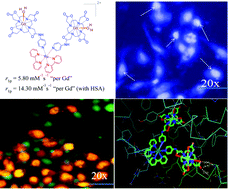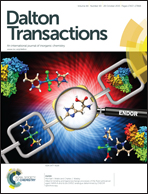Synthesis, relaxivity, and in vitro fluorescence imaging studies of a novel d–f heterometallic trinuclear complex as a potential bimodal imaging probe for MRI and optical imaging†
Abstract
A new trinuclear heterometallic RuII–GdIII2 complex of 4-aminopyridine appended DO3A (DO3A = 1,4,7-tris(carboxymethyl)-1,4,7,10-tetraazacyclododecane) with 2,2′-bipyridine as ancillary ligands is synthesized and its relaxometry and in vitro fluorescence imaging studies are reported. The complex [Ru(bpy)2{Gd(DOTA-AMpy)(H2O)}2]Cl2 (7) exhibits a “per Gd” longitudinal relaxivity (r1p) of 5.80 and 14.30 mM−1 s−1 in aqueous solution and in the presence of HSA, respectively (20 MHz, pH = 7.4, PBS, 37 °C). The complex 7 exhibits an intense 1MLCT absorption band at 480 nm and luminesces at 595 nm with a luminescence quantum yield of 3.2%. The fluorescence microscopy imaging study of HeLa cells incubated with 7 and stained with ethidium bromide and acridine orange confirms that the cells are viable throughout the imaging experiments and its cytotoxicity against HeLa cells, studied by the MTT assay, demonstrates its use for bioimaging studies. HeLa cell lines treated with the complex 7 and stained with Hoechst-33342 showed marked morphological signs of apoptosis in a dose-dependent manner by inducing changes in cell cycle arrest at the G2/M phase. Furthermore, apoptosis of HeLa cells, studied by the DNA ladder assay, indicates apoptotic cell death lending support for the antitumor activity of 7. A molecular docking study reveals that the complex 7 intercalates into the major groove of the DNA stabilized by hydrogen bonding and it binds with HSA by electrostatic- and hydrogen bonding interactions. The relaxometry, luminescence and fluorescence imaging studies indicate that the RuII–GdIII2 complex 7 has a good cell membrane permeability and could be considered as a potential bimodal imaging probe.


 Please wait while we load your content...
Please wait while we load your content...